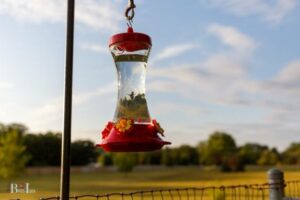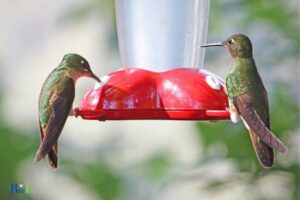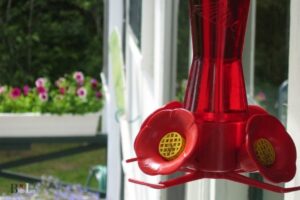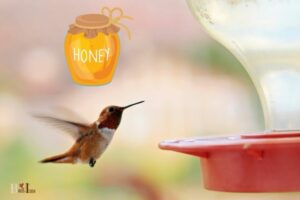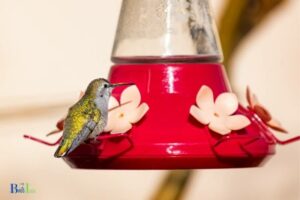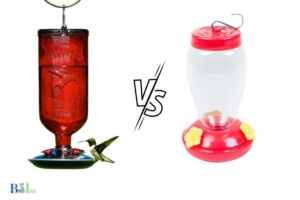When to Fill Hummingbird Feeders in Texas: Mar-Oct!
In Texas, the ideal time to fill hummingbird feeders is from early March to late October, when hummingbirds are most active in the region.
Hummingbirds are migratory birds, meaning they travel between their breeding and non-breeding grounds. In Texas, these tiny creatures typically arrive during early spring (March) and stay through the summer and early fall months (late October).
By providing well-maintained feeders during this period, you can help support these birds as they go through their breeding season and prepare for their long migration journey.
To create a hummingbird-friendly environment in Texas, remember to clean and refill your feeders consistently every 3-5 days to keep the sugar water fresh.
In addition, it’s wise to plant native flowers and plants that naturally provide nectar and attract those tiny visitors to your garden. By doing so, you’ll not only enjoy the beauty of hummingbirds, but also support them during their migration and breeding seasons.
12 Month Schedule for Filling Hummingbird Feeders in Texas
| Month | Feeding Recommendation |
| January | Not required |
| February | Suggested |
| March | Recommended |
| April | Highly recommended |
| May | Highly recommended |
| June | Highly recommended |
| July | Highly recommended |
| August | Highly recommended |
| September | Recommended |
| October | Suggested |
| November | Not required |
| December | Not required |
Key Takeaway
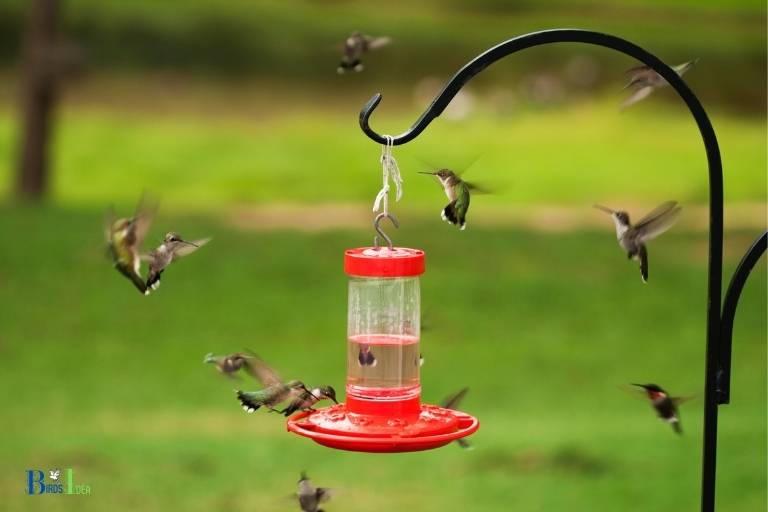
Five Facts About: Feeding Hummingbirds in Texas
Understanding When To Fill Hummingbird Feeders In Texas
Hummingbirds are fascinating creatures and to observe them hovering delicately over a beautiful flower is a sight to behold. However, if you reside in texas, you don’t need to wait for a natural habitat for those amazing birds to thrive.
Hummingbird feeders are a great way to attract these beautiful tiny birds to your backyard or balcony and enjoy their presence.
Introduction To Hummingbird Feeders And Their Importance In Texas
In texas, hummingbirds are quite common, especially during their migration period. These tiny birds require a high-energy diet to support their long-distance flights, and hummingbird feeders can be a lifesaver for them.
Here are some critical points on the importance of hummingbird feeders in texas:
- Natural nectar sources are unpredictable and can be insufficient during droughts, so hummingbird feeders can be a reliable source of food for them.
- When it comes to food, hummingbirds are territorial, and by adding a hummingbird feeder at your residence, you can enjoy the premium sight, sound and enjoyment of these magnificent creatures visiting your garden.
- Hummingbirds are essential pollinators, and by putting out a hummingbird feeder, it can attract them to your garden and help pollinate your flowering plants.
Maintaining a hummingbird feeder requires careful consideration. That said, we have some key points to understand when to fill your hummingbird feeders in texas.
- Hummingbirds require quite a bit of energy and feed frequently, especially during warmer months. During peak summer months, it’s best to check and refill your feeder every two to three days.
- Texas’ climate is highly variable, but different seasonal changes can affect hummingbird feeder maintenance. In the spring and summer, when the temperature warms up, you may need to replace the nectar solution more frequently.
- During colder months, you may not need to replace the nectar solution as often. However, it’s always best to keep an eye on the feeder and ensure it still has fresh nectar available.
So, there you have it – some key points to bear in mind when it comes to hummingbird feeders in texas. Remember, it’s crucial to keep the hummingbird feeder clean and well-maintained to prevent the growth of harmful mold or bacteria.
If you are passionate about welcoming hummingbirds to your backyard, then creating a healthy and suitable environment for them, including food sources, shelter and nesting sites, should be one of your top priorities.
Ideal Time To Fill Hummingbird Feeders
Best Time For Filling Hummingbird Feeders
Hummingbirds are pretty active creatures throughout the year in texas, and if you’re lucky enough to have them in your backyard, it’s essential to keep their feeders full. But what is the best time to fill hummingbird feeders?
Here are a few things to remember:
- The ideal time to fill hummingbird feeders is during the early morning or late evening when the temperatures are cooler. Hummingbirds tend to be most active during these times, so it’s when they’ll be most likely to visit your feeder.
- The perfect time to fill your feeder is right before sunset. This way, the hummingbirds can feed until the sun goes down, and they’ll have enough energy to conserve themselves throughout the night.
- Make sure to refill your hummingbird feeder at least once a week, no matter the season.
Temperature And Climate Considerations In Texas
Texas is a large state with varying temperatures throughout the year and different climates in different regions. It’s essential to take these temperature and climate considerations into account when filling your hummingbird feeder.
Here are some key things to keep in mind:
- In the spring, you should expect temperatures to fluctuate between 60-80 degrees. This is a crucial time for hummingbirds to return to texas, and they’ll be in search of food. Keep your feeders filled, so they have plenty to eat.
- Summer temperatures in texas can soar over 100 degrees, so it’s essential to keep your feeder in a shaded area to keep the nectar from spoiling too quickly. Make sure to clean and refill the feeder every 2-3 days to prevent mold or bacteria buildup.
- Fall is typically the migration period for hummingbirds in texas. Keep your feeder accessible until mid-october, and be sure to keep it full while they fuel up before their journey south.
How Frequently To Fill Hummingbird Feeders
Hummingbirds are tiny creatures, and they have incredibly high metabolic rates. As a result, they need to eat around ½ to 2/3 of their body weight daily, which means that they’ll consume your nectar quickly.
Here are a few things to remember when it comes to refilling your hummingbird feeders:
- Refill your feeders often, especially during the spring and summer months when hummingbirds are most active and have higher metabolic rates. Consider refilling your feeder every day or two, depending on how quickly your hummingbirds go through the nectar.
- Keep a close eye on your feeder’s syrup level, and remember to top it off when it gets halfway empty. An empty feeder can prevent hummingbirds from returning, so be sure to keep it filled.
- Remember to clean and sanitize your feeder every week, regardless of how often it’s empty. Mold and bacteria buildup can be harmful to hummingbirds, and it will ultimately cause them to avoid your feeder.
Signs That Hummingbird Feeders Need Refilling
When it comes to hummingbirds, providing them with nectar is an essential way to help them thrive. But how do you know when to refill their feeders, especially in texas where they stay year-round?
In this post, we’ll focus on the signs that hummingbird feeders need refilling, how to tell if hummingbirds are consuming the nectar, and understanding the feeder’s condition.
Signs Of Empty Or Near-Empty Hummingbird Feeders
- Decreased bird traffic: When hummingbirds stop visiting the feeder, it may be empty or near empty. If you observe this behavior, check the feeder immediately.
- Low nectar level: Check the level of the liquid or syrup in the feeder daily. If the level is low, it could indicate that the nectar is almost gone.
- Crystallization: Crystallization happens when the nectar is left in the feeder for too long, making it solid. When this occurs, it’s time to clean the feeder and refill it with fresh nectar.
How To Tell If Hummingbirds Are Consuming The Nectar
- Frequent visits: If you notice an increase in hummingbird traffic around the feeder, it means they are consuming the nectar.
- Cleanliness: Hummingbirds are drawn to clean feeders, so if you see them at the feeder frequently, it indicates they’re consuming the nectar.
- Empty container: If the liquid in the feeder is disappearing quickly, it means the hummingbirds are consuming it.
Understanding The Feeder’S Condition
- Cleaning: Regular cleaning is necessary to keep the feeder in good condition and keep the hummingbirds healthy. Clean the feeder once every 3-5 days, or more frequently if it looks dirty.
- Damage: Check the feeder occasionally for damage caused by weather, accidental knocks, or predators. If there is damage, repair or replace the feeder immediately.
- Leakage: Hummingbird feeders are prone to leaking, which can lead to wet feathers and can cause a cold on the birds. Inspect the feeder regularly for leaks and repair them if any exist.
It’s crucial to refill hummingbird feeders regularly to attract and help these beautiful birds thrive. By looking out for these signs, people can ensure they provide fresh nectar to support the hummingbirds.
Regular checking of the feeder’s condition is also essential to maintain the feeder’s usability and the health and safety of the hummingbirds.
Keeping Hummingbird Feeders Fresh And Attractive
When To Fill Hummingbird Feeders In Texas
Hummingbirds are attracted to texas’ warm climate and abundant flowering plants. Supplementing their natural diet with a hummingbird feeder can entice these tiny birds to visit your yard more often.
However, maintaining the feeder requires a bit of effort. In this post, we’ll discuss the best practices for keeping hummingbird feeders fresh and attractive, tips for preventing mold and bacteria growth, and ways to attract hummingbirds to your feeder.
Best Practices For Maintaining Hummingbird Feeders
There are several best practices to keep in mind when maintaining your hummingbird feeder.
Here are a few key points:
- Clean the feeder every 2-3 days with hot, soapy water and a bottle brush to remove any mold or bacteria.
- Rinse the feeder thoroughly with hot water to remove all soap residue.
- Refill the feeder with fresh nectar immediately after cleaning, and avoid filling it over the maximum fill line.
- Replace the feeding solution every 4-5 days, or more frequently if it appears cloudy or contains debris.
- Place the feeder in a shaded area to prevent the nectar from spoiling too quickly in the hot sun.
Tips For Preventing The Growth Of Mold And Bacteria
Mold and bacteria are common problems with hummingbird feeders, but they can be prevented by following these tips:
- Clean the feeder thoroughly every 2-3 days.
- Use a feeder with fewer nooks and crannies where mold and bacteria can grow.
- Use a nectar solution with a higher ratio of sugar to water (e.g., 4: 1 instead of 3:1) to slow down fermentation.
- Avoid using honey or artificial sweeteners in the nectar solution, which can promote bacterial growth.
How To Attract Hummingbirds To Your Feeder
Attracting hummingbirds to your feeder is easy if you follow these tips:
- Use a red feeder and nectar solution, which mimics the color of natural nectar and attracts hummingbirds.
- Hang the feeder near flowering plants or in an area where hummingbirds are known to frequent.
- Provide a shallow water source nearby, such as a birdbath or fountain, for hummingbirds to drink and bathe.
- Avoid using pesticides or insecticides in your yard, which can harm hummingbirds and their food sources.
Maintaining your hummingbird feeder requires regular cleaning and fresh nectar. Follow these best practices and tips to prevent mold and bacteria growth and attract hummingbirds to your feeder.
Remember, these tiny birds are a joy to watch and worth the effort to keep them healthy and happy.
Choosing The Right Type Of Nectar
When it comes to filling hummingbird feeders in texas, choosing the right type of nectar is crucial. As a responsible feeder, it’s your responsibility to provide the hummingbirds with the right nutrition, so they can thrive and stay healthy.
Here are some essential things you need to know when choosing the perfect nectar for your hummingbirds.
Understanding The Nutritional Requirements Of Hummingbirds
Hummingbirds are nectarivores, which means they mostly feed on nectar to get energy and nutrients to fuel their metabolism. However, not all nectars are created equal, and hummingbirds require specific nutrients for their health and wellbeing.
Some essential nutrients that hummingbirds need are:
- Proteins
- Carbohydrates
- Minerals
- Vitamins
Proteins are needed for growth, repair, and reproduction. Carbohydrates are the primary source of energy, minerals like calcium and iron are necessary for bone formation, and vitamins like vitamin a, c, and e help in the maintenance of feathers and overall immune function.
The Different Types Of Nectar Available In Texas
In texas, you’ll find different types of nectar in stores, and each has its pros and cons.
Here are some of the most common types of nectar available:
- Clear nectar: This is the most common type of nectar you’ll find in stores, and it’s a mix of water and granulated sugar. It’s readily available, but some brands may contain preservatives, which may not be healthy for hummingbirds.
- Organic nectar: Organic nectars are free from preservatives and other harmful additives, but they can be more expensive than regular nectars.
- Red nectar: Red nectars are often marketed as hummingbird nectar, but they may contain artificial colorings and flavors that may not be healthy for hummingbirds.
Homemade Nectar Vs. Store-Bought Nectar
Making your nectar at home can be a great way to ensure that your hummingbirds are getting the purest nectar possible.
Here’s a simple recipe you can try at home:
- Mix four parts water with one-part granulated sugar.
- Boil the mixture for 1-2 minutes.
- Allow it to cool before pouring it into the feeder.
However, if you’re not comfortable making your nectar, you can buy store-bought nectar provided it meets the necessary nutritional standards.
Remember, hummingbirds need the right nutrition to stay healthy and thrive, so choose the right type of nectar wisely. By providing your hummingbirds with the right nectar, you’ll be supporting their healthy growth and survival.
FAQ Of When To Fill Hummingbird Feeders In Texas
What Is The Best Time To Fill Hummingbird Feeders In Texas?
How Often Should I Refill My Hummingbird Feeder In Texas?
Should I Clean My Hummingbird Feeder Between Refilling?
What Is The Best Location To Place A Hummingbird Feeder In Texas?
Conclusion
Hummingbirds are a delight to watch, and providing them with food can be a rewarding experience. In texas, climate plays a major role in determining the frequency of feedings. During the summer months, more frequent meal refills may be necessary to compensate for the high temperature.
Choosing the right feeder and location also makes a big difference in the activity level of the birds. Opt for feeders with bee guards and avoid placing them in direct sunlight to keep the nectar fresh and safe.
Lastly, always remember to clean the feeders regularly to prevent bacterial growth.
With the right tools and knowledge, you can enjoy the company of hummingbirds year-round. By filling your feeder at the perfect time, you can attract these fascinating creatures to your backyard and help sustain their migration along the way.
Take care of your hummingbirds, and they will bring a flurry of joy to your life.

